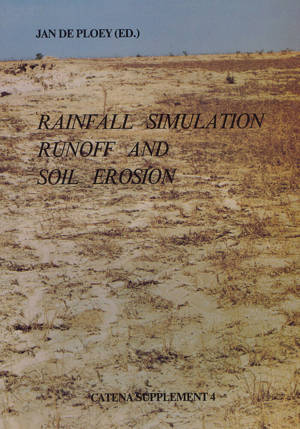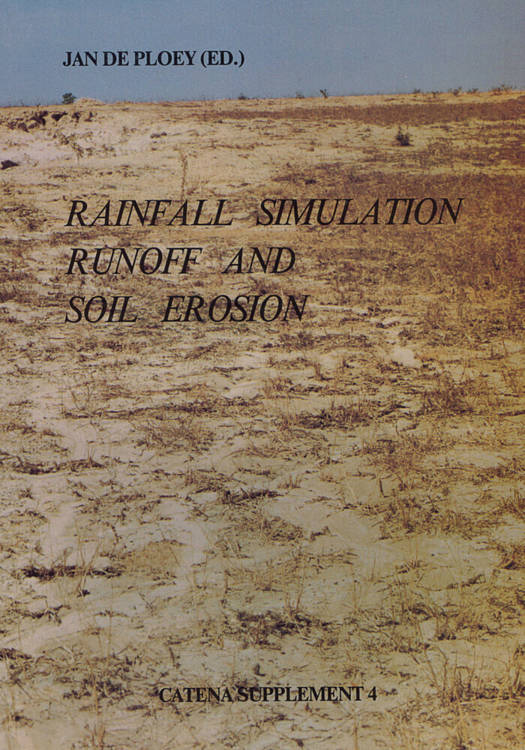
- Retrait gratuit dans votre magasin Club
- 7.000.000 titres dans notre catalogue
- Payer en toute sécurité
- Toujours un magasin près de chez vous
- Retrait gratuit dans votre magasin Club
- 7.000.0000 titres dans notre catalogue
- Payer en toute sécurité
- Toujours un magasin près de chez vous
Rainfall Simulation Runoff and Soil Erosion
60,45 €
+ 120 points
Description
This volume includes an important contribution to the knowledge of active soil erosion, especially in typical sites in the Mediterranean belt, where soil degradation is very acute. On the other hand a set of papers is presented which enlighten the important role of laboratory research in the fundamental parametric investigation of processes, i.e. erosion by rain. This is in line with the progressing integration of field and laboratory studies, which is stimulated by more frequent feed-back operations. Finally we want to draw attention to the work of a restricted number of authors who are engaged in the difficult elaboration of pure theoretical models which may pollinate empirical research, by providing new concepts to be tested. Therefore, the fairly extensive publication of two papers by Culling on soil creep mechanisms, whereby the basic force-resistance problem of erosion is discussed at the level of the individual particles. All the other contributions are focused mainly on the processes of erosion by rain. The use of rainfall simulators is very common nowadays. But investigators are not always able to produce full fall velocity of waterdrops. Epema & Riezebos give complementary information on the erosivity of simulators with restricted fall heights. Moeyersons discusses splash erosion under oblique rain, produced with his newly-built S.T.O.R.M-1 simulator. This important contribution may stimulate further investigations on the nearly unknown effects of oblique rain. Bryan & De Ploey examined the comparability of erodibility measurements in two laboratories with different experimental set-ups. They obtained a similar gross ranking of Canadian and Belgian topsoils. Both saturation overland flow and subsurface flow are important runoff sources under the rainforests of northeastern Queensland. Interesting, there, is the correlation between soil colour and hydraulic conductivity observed by Bonell, Gilmour& Cassells. Runoff generation was also a main topic of Imeson's research in northern Morocco, stressing the mechanisms of surface crusting on clayish topsoils. For southeastern Spain Thornes & Gilman discuss the applicability of erosion models based on fairly simple equations of the "Musgrave-type". After Richter (Germany) and Vogt (France) it is Tropeano who completes the image of erosion hazards in European vineyards. He shows that denudation is at the minimum in old vineyards, cultivated with manual tools only. Also in Italy van Asch collected important data about splash erosion and rainwash on Calabrian soils. He points out a fundamental distinction between transport-limited and detachment-limited erosion rates on cultivated fields and fallow land. For a representative first order catchment in Central-Java van der Linden comments contrasting denudation rates derived from erosion plot data and river load measurements. Here too, on some slopes, detachment-limited erosion seems to occur. The effects of oblique rain, time-dependent phenomena such as crusting and runoff generation, detachment-limited and transport-limited erosion including colluvial deposition, are all aspects of single rainstorms and short rainy periods for which particular, predictive models have to be built. Moreover, it is argued that flume experiments may be an economic way to establish gross erodibility classifications. The present volume may give an impetus to further investigations and to the evaluation of the proposed conclusions and suggestions.
Spécifications
Parties prenantes
- Editeur:
Contenu
- Nombre de pages :
- 214
- Langue:
- Anglais
- Collection :
- Tome:
- n° 4
Caractéristiques
- EAN:
- 9783510653454
- Format:
- Livre broché
- Dimensions :
- 170 mm x 240 mm
- Poids :
- 510 g

Les avis
Nous publions uniquement les avis qui respectent les conditions requises. Consultez nos conditions pour les avis.





